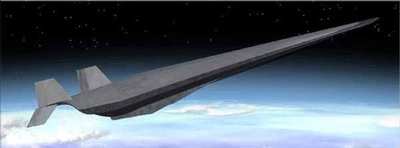Wed, Aug 03, 2005
Mach 7 Tests Planned Next Year
 Pratt & Whitney (P&W) Space
Propulsion recently completed fabrication of a hypersonic Ground
Demonstration Engine (GDE-2) successfully completing a three-phase,
nine-year, $58 million contract with the US Air Force Research
Laboratory (AFRL). The GDE-2 is unique in that it features a
variable geometry inlet and a bolted construction, simulating the
configuration of a reusable access-to-space or global-reach
propulsion system.
Pratt & Whitney (P&W) Space
Propulsion recently completed fabrication of a hypersonic Ground
Demonstration Engine (GDE-2) successfully completing a three-phase,
nine-year, $58 million contract with the US Air Force Research
Laboratory (AFRL). The GDE-2 is unique in that it features a
variable geometry inlet and a bolted construction, simulating the
configuration of a reusable access-to-space or global-reach
propulsion system.
The GDE-2 is undergoing preparations for testing at NASA-Langley
Research Center (LaRC). The first phase of the test program, which
will evaluate the engine's operation and performance at Mach 5
conditions, is scheduled to begin in October.
"GDE-2 is a fully integrated engine that will lead to advances
in hypersonic flight systems," said P&W's Hydrocarbon Scramjet
Engine Technology (HySET) Program Manager Denis Medwick. "This will
be the first time a hydrocarbon-fueled scramjet propulsion system,
which includes a single integrated flow path, fuel control system,
closed-loop thermal management system and a Full Authority Digital
Engine Control, is tested at hypersonic conditions." P&W is
developing hypersonic propulsion systems for strike, global-reach
and access-to-space applications.
The GDE-2 program will examine the functionality of these
integrated technologies during Mach 5 ground testing. A second test
program to evaluate the operation of the engine at Mach 7
conditions is planned for next year. A P&W, US Air Force and
Boeing team will use results from the GDE-2 test program in their
Scramjet Engine Demonstrator - Wave Rider flight demonstration
program scheduled to fly in 2008.

The GDE-2 engine was developed under the HySET program, a
three-phase hypersonic technology program sponsored by the AFRL to
develop and demonstrate a Mach 4-8 hydrocarbon-fueled scramjet
propulsion system.
In July 2003, P&W Space Propulsion teamed with US Air Force
researchers under the HySET program and completed ground testing of
the GDE-1 engine at speeds of Mach 4.5 and Mach 6.5. GDE-1 was the
world's first flight-weight, hydrocarbon-fueled scramjet engine. It
used standard JP-7 fuel to cool both engine hardware and fuel the
engine's combustor.
More News
“While legendary World War II aircraft such as the Corsair and P-51 Mustang still were widely flown at the start of the Korean War in 1950, a new age of jets rapidly came to >[...]
Decision Altitude (DA) A specified altitude (mean sea level (MSL)) on an instrument approach procedure (ILS, GLS, vertically guided RNAV) at which the pilot must decide whether to >[...]
Aero Linx: National Aviation Safety Foundation (NASF) The National Aviation Safety Foundation is a support group whose objective is to enhance aviation safety through educational p>[...]
Also: Cal Poly Aviation Club, $$un Country, Arkansas Aviation Academy, Teamsters Local 2118 In response to two recent general aviation accidents that made national headlines, more >[...]
“The FAA is tasked with ensuring our skies are safe, and they do a great job at it, but there is something about the system that is holding up the medical process. Obviously,>[...]
 Aero-News: Quote of the Day (04.28.25)
Aero-News: Quote of the Day (04.28.25) ANN's Daily Aero-Term (04.28.25): Decision Altitude (DA)
ANN's Daily Aero-Term (04.28.25): Decision Altitude (DA) ANN's Daily Aero-Linx (04.28.25)
ANN's Daily Aero-Linx (04.28.25) Airborne-Flight Training 04.24.25: GA Refocused, Seminole/Epic, WestJet v TFWP
Airborne-Flight Training 04.24.25: GA Refocused, Seminole/Epic, WestJet v TFWP Aero-News: Quote of the Day (04.29.25)
Aero-News: Quote of the Day (04.29.25)




